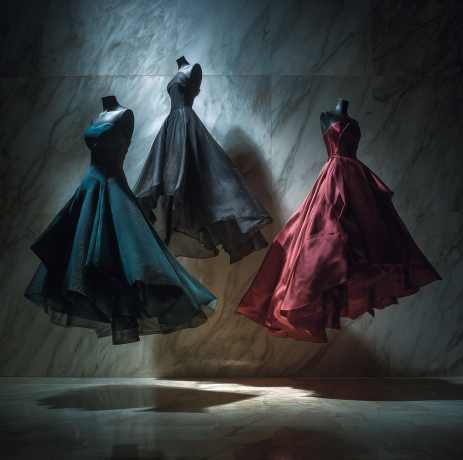please click here:
Introduction to Dresses
Dresses have remained timeless garments, transcending cultures, fashion eras, and lifestyles. From ancient robes to modern couture, dresses symbolize femininity, elegance, and personal expression. They are not only pieces of clothing but also reflections of history, art, and individuality. In today's world, the variety of dresses spans from casual everyday wear to luxurious evening gowns, each designed with purpose and personality.
This article explores the world of dresses in depth, analyzing styles, fabrics, cultural influences, and fashion trends. Whether you are seeking guidance for your next purchase or curious about how dresses shape identity, you'll find practical knowledge and fresh perspectives here.
The Evolution of Dresses Through History
Fashion evolves, but dresses have consistently remained at the forefront of change.
Ancient Origins
In ancient Egypt and Mesopotamia, dresses were crafted from linen, reflecting practicality in hot climates. Greece and Rome celebrated draped garments like the chiton and toga, laying the foundation for Western dress silhouettes.
The Middle Ages
European dresses emphasized status, with layered fabrics, embroidery, and elaborate sleeves. Social hierarchy was visually reinforced through attire.
The Renaissance and Beyond
Corsetry and structured gowns dominated during the Renaissance, while the Victorian era introduced crinolines and bustles, symbolizing grandeur and rigid social norms.
Modern Revolution
The 20th century redefined dresses with Coco Chanel's little black dress, Dior's “New Look,” and the rise of ready-to-wear fashion. Today, minimalism, inclusivity, and sustainability drive new approaches to dress design.
Popular Types of Dresses
Modern fashion offers endless variations. Understanding them helps with styling choices.
Casual Dresses
-
Shirt dress: Relaxed yet polished
-
Sundress: Lightweight, perfect for summer
-
T-shirt dress: Minimalist and versatile
Formal Dresses
-
Evening gown: Long, often embellished for gala occasions
-
Cocktail dress: Knee-length, sophisticated, ideal for semi-formal events
-
Ball gown: Voluminous, designed for grandeur
Work and Professional Dresses
-
Sheath dress: Slim fit, structured, professional
-
Wrap dress: Flattering silhouette with comfort
-
Midi dress: Balances modesty and elegance
Special Cultural Dresses
-
Cheongsam/Qipao (China): High-necked, figure-hugging elegance
-
Kimono (Japan): Symbolic, ceremonial artistry
-
Sari (India): Draped sophistication blending tradition and beauty
Dress Fabrics and Their Impact
Fabric determines comfort, appearance, and durability.
| Fabric Type | Characteristics | Best For |
|---|---|---|
| Cotton | Breathable, lightweight | Casual summer dresses |
| Silk | Luxurious, smooth, delicate | Evening gowns, formalwear |
| Linen | Crisp, airy, absorbs moisture | Warm climates, sundresses |
| Wool | Warm, insulating, structured | Winter dresses, workwear |
| Polyester | Affordable, wrinkle-resistant | Everyday wear |
| Velvet | Rich texture, elegant | Party dresses, evening gowns |
The choice of fabric not only influences look and feel but also determines sustainability and maintenance. For example, organic cotton and recycled polyester are becoming popular in eco-conscious fashion.
Dresses and Body Shapes
The beauty of dresses lies in their ability to flatter different body types.
Hourglass Shape
Best styles: Wrap dresses, fit-and-flare designs that emphasize the waist.
Pear Shape
Best styles: A-line dresses, empire waistlines that balance proportions.
Apple Shape
Best styles: Shift dresses, flowy designs that draw attention away from the midsection.
Rectangle Shape
Best styles: Belted dresses, peplum silhouettes that add curves.
Seasonal Dress Choices
Dresses adapt beautifully to seasons.
-
Spring: Floral prints, light fabrics like chiffon.
-
Summer: Linen sundresses, sleeveless cuts for airflow.
-
Autumn: Midi dresses in earthy tones paired with boots.
-
Winter: Sweater dresses, layered with tights and coats.
Dresses in Contemporary Culture
Dresses carry symbolic weight beyond fashion.
Weddings
White bridal gowns symbolize purity in the West, while red wedding dresses represent luck and joy in Chinese traditions.
Red Carpet and Celebrity Influence
Celebrities elevate dresses into statements of power, artistry, and brand representation. Think of iconic Oscars gowns or Met Gala ensembles.
Everyday Empowerment
Many women describe wearing a dress as transformative, giving them confidence and comfort simultaneously. Dresses are not just aesthetics; they are psychological armor.
Comparing Dresses: Ready-to-Wear vs. Couture
| Category | Ready-to-Wear | Couture |
|---|---|---|
| Production | Mass-produced | Handcrafted, custom-fitted |
| Price | Affordable to premium | Extremely expensive |
| Accessibility | Available globally | Exclusive, limited |
| Style | Trend-driven, practical | Artistic, experimental |
| Lifespan | Moderate | Often heirloom-quality |
The Role of Technology and Sustainability
The future of dresses intertwines with innovation.
-
3D Printing: Designers experiment with futuristic, sculptural dresses.
-
Smart Fabrics: Dresses that regulate temperature or monitor health.
-
Sustainable Fashion: Ethical sourcing, recycled materials, and zero-waste patterns are transforming production.
Styling Dresses: Accessories and Footwear
A dress is never just a dress—it becomes complete with the right styling.
-
Shoes: Heels elevate elegance, sneakers add casual charm.
-
Bags: Clutches for formality, crossbody bags for ease.
-
Jewelry: Statement necklaces for simplicity, minimal studs for bold gowns.
Tips for Buying the Perfect Dress
-
Identify your purpose: casual, work, or event.
-
Consider fabric for comfort and climate.
-
Know your body shape and flattering silhouettes.
-
Balance trends with timeless pieces.
-
Try second-hand or sustainable brands for eco-friendly choices.
Frequently Asked Questions
- What is the difference between a gown and a dress?
A gown usually refers to a long, formal dress, often associated with evening or ceremonial occasions, whereas a dress is a broader term for garments of varying lengths and purposes. - Which dress styles are best for everyday wear?
T-shirt dresses, shirt dresses, and sundresses are ideal for casual and comfortable everyday wear. - How do I choose the right fabric for a dress?
Consider the season and event. Cotton and linen are best for summer, silk for luxury, and wool for colder months. - What's the most versatile dress length?
The midi length is highly versatile, balancing elegance with practicality across casual and formal occasions. - Are sustainable dresses worth the investment?
Yes. Though often more expensive, sustainable dresses are ethically produced, durable, and reduce environmental impact.
Summary
Dresses are timeless garments that merge fashion, culture, and individuality. This guide explores history, styles, fabrics, and modern innovations, offering insights into how to choose, wear, and appreciate dresses across occasions, body types, and evolving trends.






